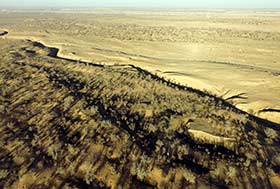Saving China from 'cancer of the Earth'
 |
|
Guo Wangang, head of Babusha Forest Farm, inspects plants growing in a previously barren area of Gulang county, Gansu province.[Photo/China Daily] |
"The checkerboards have remarkable properties - acting as windbreaks and helping to keep dunes in place, thus allowing topsoil to form. When a sufficient amount of soil has been established, drought-resistant plants can be grown," he said.
Liu Shizeng, director of the Gansu Desert Control Research Institute in Lanzhou, the provincial capital, said China originally adopted anti-desertification measures used in the former Soviet Union, but quickly started exploring its own techniques.
"In addition to improving anti-desertification techniques that were adopted in different geographical circumstances, we also encouraged the control of desertification through the development of local businesses, such as those that plant shrubs and dune plants to fix the sand in place and prevent major shifts. This has encouraged more locals to participate," he said.
According to Tian Zhiguo, deputy head of Pingchun, a county in Gansu, before the development of the dune plant industry, local residents rarely played an active role in tree planting.
"The cost of planting trees in deserts is very high, and once planted, the trees were not allowed to be cut down for sale. So, it made sense for them not to participate," he said. "Now, with plant farms generating profits, the locals are more willing to join the campaign."
National desert parks
Liu said years of research have resulted in the maturation of technologies that enable the large-scale domestic cultivation of wild plants, such as Asian onions. Moreover, homegrown techniques have already provided support to the development of the "sand industry" along the Hexi corridor, a fertile region which provides most of the crops grown in Gansu.
"Another good example is the founding and construction of national desert parks, which provide effective management of deserts and maximize their value," he added.
Since August 2013, the State Forestry Administration has approved 70 pilot projects for national desert parks and has pledged to build 170 by 2020, accounting for 2.4 percent of the estimated area of sandified land that can be reclaimed across the country.
Liu has been dealing with deserts for more than 30 years. At first, he regarded them as essentially dangerous places because they can destroy people's lives and livelihoods.
Now, he has changed his mind: "Just like the ocean, a desert is a natural landscape. Not all of it is dangerous to humans."
Wang Zengji, deputy head of the forestry bureau of Yanchi county in Ningxia, said combating desertification does not equate to "eradicating" deserts.
"Instead, it is the management of desertified land caused by human activities," he said.
Guo Shaoyu in Yinchuan contributed to this story.
Contact the writers at suzhou@chinadaily.com.cn




















